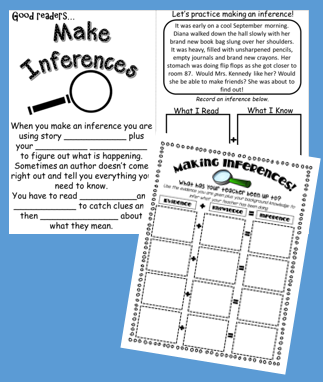I hope everyone had a wonderful holiday!
I am working on some activities to ease my students and I into the new year.
We ended 2015 reading the ADORABLE story of Osbert the Penguin.
In this story, a little boy wishes for a real live penguin and Santa delivers.
The boy soon learns that taking care of a penguin is harder than he thinks.
We were working on story structure right before winter break and this story was perfect for an analysis of character, setting problem and solution.
It is also a good one to practice summary writing.
I like using the "Somebody, Wanted, But, So" summary writing technique for this story.
We use a lot of these types of open ended templates to report about our reading.
I like using a variety of them so students have some choice as to how they are going to respond.
Here is a fun one that I have done in the past. Students summarize the story and then rate the
book by giving it a certain number of penguin points.
You can find all three of these plus the rest of my Penguin resources in the following
bundle:
Click the link below to head to my TPT Store:
When we head back to school I will be introducing the very important reading skill of "Making Inferences". I will introduce the Inference Equation using this anchor chart:
Then my student detectives will be trying to figure out what their teacher has been doing over winter break by using clues I give them. They will be using evidence plus background knowledge to make inferences.
Following that we will be reading another fun penguin book that works well for making inferences.
The Tacky the Penguin books are perfect "speedy readies" for third graders.
Tacky and the Winter Games is a Win Win book for me since while it will help me to teach how to make an inference, it is also a great tie in to our social studies unit. We just learned about the Ancient Greeks and how one of the contributions from this civilization was the Olympic Games.
.
I just LOVE Helen Lester's books. They always include great "juicy" words that we can add to our vocabulary vault.
In this silly book, Tacky is going to be competing in the winter games.
His penguin friends are named Goodly, Lovely, Angel, Neatly and Perfect and they work hard to prepare for the competition. This book is a laugh out loud tale of a penguin who is less than perfect, yet keeps a positive outlook and is able to help his team achieve victory.
I am excited to share this book with my third graders also because it relates so well to our focus on maintaining healthy mindsets.
There has been a lot of talk recently about how a child's mindset can determine the extent of his/her academic and personal success. Entire books have been written about the importance of fostering a healthy "growth mindset".
In this insightful book, Carol Dweck discusses the difference between a fixed and growth mindset.
A “fixed mindset” assumes that our character, intelligence, and creative ability are static givens which we can’t change in any meaningful way, and success is the affirmation of that inherent intelligence, an assessment of how those givens measure up against an equally fixed standard; striving for success and avoiding failure at all costs become a way of maintaining the sense of being smart or skilled. A “growth mindset,” on the other hand, thrives on challenge and sees failure not as evidence of unintelligence but as a heartening springboard for growth and for stretching our existing abilities. Out of these two mindsets, which we manifest from a very early age, springs a great deal of our behavior, our relationship with success and failure in both professional and personal contexts, and ultimately our capacity for happiness
I am such a believer in this philosophy that I created a "Healthy Mindset Talk" display which hangs in my room. We refer to it as we learn and especially when we are ready to tackle something especially tough.
You can find this set at my TPT store. Check it out here:
My plan is to reinforce the idea that even young people have control over what they learn and how they do in school with a "Happy New Year" writing activity when we get back.
Again, I love to connect our reading and writing to our social studies learning whenever possible and this does just that. We will learn that the word "January" comes from the Roman god named Janus. He was depicted with two faces. One looking backwards and one forwards.
I am going to have my students draw a picture of themselves as Janus and then write a goal they want to make for themselves.
They will write what their goal is, why it is an important goal for them to make and how they plan on achieving the goal.

You can find this to download on my TPT store.
What are you plans for 2016?
Would love to hear!
Email Me; youngdor8@gmail.com





















































 youngdor8@gmail.com
youngdor8@gmail.com



















